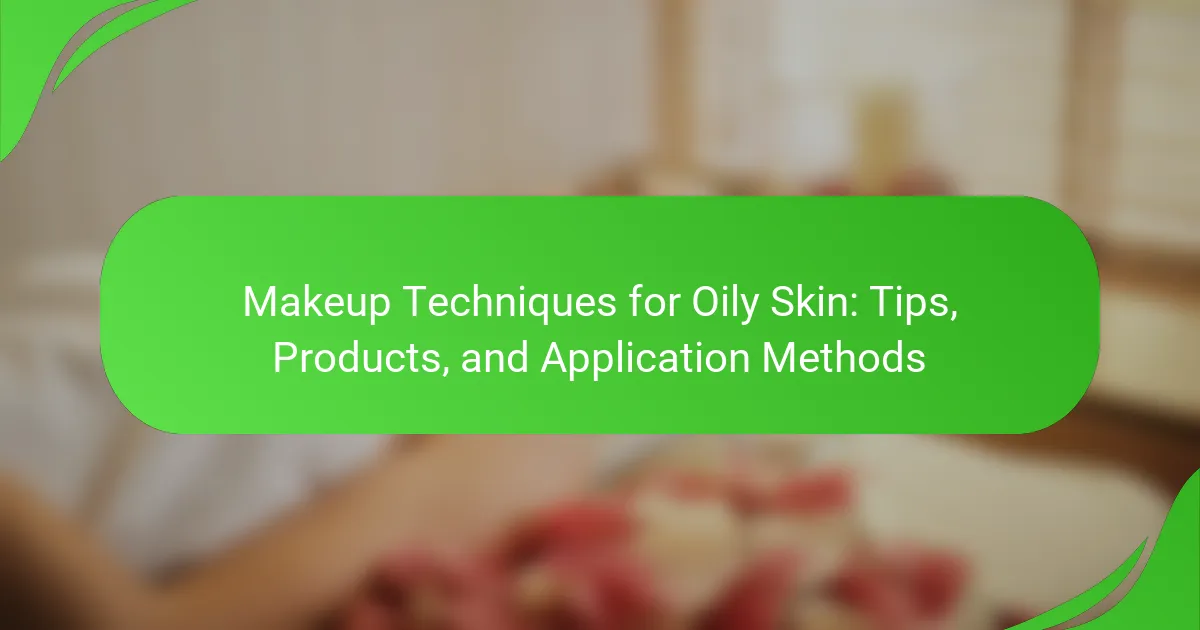Makeup techniques for oily skin focus on controlling shine and ensuring long-lasting wear through specific products and application methods. Key products include mattifying primers, oil-free foundations, and setting powders, which work together to create a smooth base and prevent excess oil production. Effective application techniques involve using a damp sponge for even foundation distribution and setting makeup with powder to absorb shine. Additionally, incorporating oil-free moisturizers and mineral-based powders can help maintain a matte finish while managing breakouts. These strategies collectively enhance the overall makeup experience for individuals with oily skin.

What are the best makeup techniques for oily skin?
The best makeup techniques for oily skin include using mattifying primers, oil-free foundations, and setting powders. Mattifying primers help control shine and create a smooth base. Oil-free foundations prevent excess oil production and provide a natural finish. Setting powders absorb oil and lock makeup in place for longer wear. Blotting papers can be used throughout the day to manage shine. Additionally, using products with a matte finish helps reduce the appearance of oil. These techniques are essential for achieving a long-lasting and polished makeup look on oily skin.
How can makeup techniques be adapted for oily skin types?
Makeup techniques can be adapted for oily skin types by using oil-free products and setting powders. Oil-free foundations help reduce shine and prevent breakouts. Matte primers can create a smooth base and control excess oil. Blotting papers can absorb oil throughout the day without disturbing makeup. Setting sprays with a matte finish help lock makeup in place. Non-comedogenic products prevent clogged pores. Using cream products sparingly can also reduce the risk of greasiness. These adaptations ensure a long-lasting and fresh appearance for oily skin.
What specific challenges do individuals with oily skin face when applying makeup?
Individuals with oily skin face several challenges when applying makeup. Excess oil production can lead to makeup sliding off the skin. This results in uneven application and frequent touch-ups. Oily skin often causes makeup to break down faster, leading to a shiny appearance. Pores may appear larger due to excess oil, affecting the overall look. Additionally, certain makeup products may not adhere well to oily skin. This can result in patchiness or a cakey finish. Lastly, individuals may experience increased acne breakouts from heavy makeup formulations. These challenges necessitate the use of specific products and techniques tailored for oily skin.
How do environmental factors influence makeup application on oily skin?
Environmental factors significantly influence makeup application on oily skin. High humidity levels can increase oil production, leading to makeup breakdown. Heat can cause sweat, which disrupts makeup adherence. Wind may carry dust and pollutants, affecting skin texture and makeup longevity. Cold weather can lead to dryness, prompting the need for hydrating products. These factors necessitate the use of mattifying primers and setting sprays to enhance makeup durability. Studies show that products designed for oily skin perform better in humid conditions, as they often contain oil-absorbing ingredients.
What are the essential tips for applying makeup on oily skin?
Use oil-free and mattifying products for makeup on oily skin. These products help control shine and provide a smooth finish. Start with a primer designed for oily skin. A mattifying primer can absorb excess oil and create a base for foundation. Choose a lightweight, oil-free foundation. This type of foundation reduces the risk of clogging pores. Apply foundation with a damp sponge for even coverage. Setting powder is essential to lock in makeup and minimize shine. Use a translucent powder to avoid adding extra color. Blotting papers can help manage oil throughout the day. They absorb excess oil without disturbing makeup. Finally, setting spray can provide extra longevity. A mattifying setting spray helps keep makeup in place.
How can pre-makeup skincare routines benefit oily skin?
Pre-makeup skincare routines can significantly benefit oily skin by controlling excess oil and providing a smooth base for makeup application. These routines often include cleansing, toning, and moisturizing with products specifically designed for oily skin. Cleansing removes dirt and excess oil, preventing clogged pores. Toning helps to balance skin pH and further reduce oiliness. Lightweight, oil-free moisturizers hydrate without adding extra oil. Additionally, using mattifying primers can minimize shine throughout the day. According to a study published in the Journal of Cosmetic Dermatology, proper skincare can enhance makeup longevity and improve overall skin appearance for oily skin types.
What setting techniques help maintain makeup longevity on oily skin?
Using setting techniques can significantly enhance makeup longevity on oily skin. First, apply a mattifying primer to control oil production. This helps create a smooth base for makeup application. Next, choose a long-wear foundation specifically designed for oily skin types. These foundations often contain oil-absorbing ingredients. After foundation, use a translucent setting powder to lock in the makeup. This powder absorbs excess oil throughout the day. Additionally, setting sprays formulated for oily skin can provide extra hold. These sprays often contain oil-controlling agents. Blotting papers can be used throughout the day to remove excess oil without disturbing makeup. Implementing these techniques can lead to a more durable makeup look on oily skin.

What types of products are ideal for oily skin?
Products ideal for oily skin include oil-free moisturizers, mattifying primers, and lightweight foundations. Oil-free moisturizers hydrate without adding excess oil. Mattifying primers help control shine and create a smooth base. Lightweight foundations provide coverage without clogging pores. Additionally, mineral-based powders can absorb excess oil throughout the day. Gel-based products are also effective, as they are less likely to contribute to oiliness. Products containing salicylic acid can help manage breakouts associated with oily skin. These types of products are formulated specifically to balance oil production and maintain a matte finish.
Which foundations work best for oily skin?
Matte foundations work best for oily skin. They help control shine and provide a long-lasting finish. Look for foundations labeled as oil-free or non-comedogenic. These formulations reduce the risk of clogged pores. Popular options include Fenty Beauty Pro Filt’r Soft Matte Longwear Foundation and Estée Lauder Double Wear Stay-in-Place Makeup. Both have a reputation for staying matte throughout the day. Additionally, powder foundations can also be effective in absorbing excess oil. They provide a lightweight feel and natural finish.
What ingredients should be avoided in foundation for oily skin?
Foundations for oily skin should avoid ingredients such as heavy oils, silicones, and alcohol. Heavy oils can clog pores and increase shine. Silicones may create a barrier that traps oil, leading to breakouts. Alcohol can strip the skin of moisture, prompting excess oil production. Additionally, foundations with comedogenic ingredients can exacerbate acne. Formulations containing fragrances can irritate sensitive skin. Products with high levels of waxes may also contribute to a greasy appearance. Choosing oil-free, non-comedogenic foundations helps maintain a matte finish.
How do different foundation formulas affect oily skin?
Different foundation formulas can significantly affect oily skin. Matte foundations help control shine and absorb excess oil. They often contain oil-absorbing ingredients like silica or kaolin clay. Liquid foundations can provide a dewy finish, which may exacerbate oiliness. Powder foundations offer a lightweight option that can set makeup and reduce shine. Silicone-based foundations create a smooth texture but may lead to breakouts for some oily skin types. Water-based foundations are generally lighter and can be less likely to clog pores. Selecting the right formula is crucial for managing oiliness while achieving a desired finish.
What are the best primers for oily skin?
The best primers for oily skin include mattifying formulas that control shine. Notable options are the Smashbox Photo Finish Oil & Shine Control Primer and the Fenty Beauty Pro Filt’r Mattifying Primer. These primers are designed to absorb excess oil and minimize the appearance of pores. They often contain ingredients like silica and clay, which help to keep the skin matte throughout the day. According to a study published in the Journal of Cosmetic Dermatology, using mattifying primers can significantly reduce sebum production and improve makeup longevity for individuals with oily skin.
How do mattifying primers help control oil?
Mattifying primers help control oil by reducing shine and absorbing excess sebum. These primers contain ingredients like silica or clay that create a barrier on the skin. This barrier minimizes oil production and keeps the skin looking matte. Studies show that these ingredients can effectively reduce oiliness for several hours. Mattifying primers also help makeup adhere better, preventing it from sliding off oily skin. By providing a smooth base, they enhance the overall appearance of makeup. Many users report a significant decrease in the need for touch-ups throughout the day.
What unique attributes should a primer have for oily skin?
A primer for oily skin should have oil-free formulation. This characteristic helps prevent excess shine. Additionally, it should contain mattifying agents like silica or kaolin clay. These ingredients absorb oil and reduce the appearance of pores. A good primer should also provide long-lasting wear. This ensures makeup stays intact throughout the day. Furthermore, it should be lightweight to avoid clogging pores. Finally, a primer with a smooth texture enhances makeup application. These attributes collectively help manage oily skin effectively.

What application methods are most effective for oily skin?
The most effective application methods for oily skin include using a primer, applying foundation with a damp sponge, and setting with powder. Primers help control oil and create a smooth base. A damp sponge allows for even application and reduces excess product. Setting powder absorbs shine and keeps makeup in place. Additionally, using oil-free and mattifying products enhances longevity. Techniques such as stippling or tapping rather than swiping can also minimize oil transfer. These methods collectively help manage shine and improve makeup wear on oily skin.
How should makeup be applied to achieve a flawless look on oily skin?
To achieve a flawless look on oily skin, start with a mattifying primer. This helps control shine and creates a smooth base. Use oil-free foundation to avoid excess oil production. Apply foundation with a damp sponge for even coverage. Set the foundation with translucent powder to lock it in place. Use a setting spray to reduce shine throughout the day. Blotting papers can be used to absorb excess oil without disturbing makeup. These methods help maintain a polished appearance on oily skin.
What tools are recommended for applying makeup on oily skin?
Foundation brushes, beauty sponges, and powder brushes are recommended tools for applying makeup on oily skin. Foundation brushes provide a smooth application of liquid or cream products. Beauty sponges help to blend products seamlessly while absorbing excess oil. Powder brushes are essential for applying setting powders to control shine. Using these tools can enhance the durability of makeup on oily skin. Proper tool selection can significantly improve the overall finish and longevity of makeup.
How does layering products impact oily skin makeup application?
Layering products can significantly impact oily skin makeup application by influencing the overall finish and longevity. When multiple products are layered, they can create a heavier texture, which may exacerbate oiliness. This can lead to a cakey appearance, making it essential to choose lightweight formulations. Additionally, the order of application matters; starting with a mattifying primer can help control excess oil. Using setting powders or sprays after layering can also enhance durability. According to a study published in the Journal of Cosmetic Dermatology, proper layering techniques can improve makeup adherence and reduce shine in oily skin types.
What common mistakes should be avoided when applying makeup on oily skin?
Common mistakes to avoid when applying makeup on oily skin include skipping primer. A good primer helps control oil and creates a smooth base. Using heavy foundations can clog pores and exacerbate oiliness. Opt for lightweight, oil-free formulas instead. Neglecting to set makeup with powder can lead to shine throughout the day. Setting powders specifically designed for oily skin can help. Applying too much product can cause a cakey appearance. Use thin layers and build coverage gradually. Forgetting to blot oil during the day can lead to makeup breakdown. Regularly using blotting papers can maintain a fresh look. Lastly, using non-comedogenic products is crucial to avoid breakouts. These practices ensure a more polished and long-lasting makeup application on oily skin.
How can over-applying products affect oily skin?
Over-applying products can lead to increased oiliness in oily skin. Excessive layers can clog pores and cause breakouts. It can also disrupt the skin’s natural balance. This results in more sebum production. Furthermore, over-application may lead to a greasy appearance. This can make makeup application less effective. Studies show that heavy product use can exacerbate acne in oily skin types. Proper product application is crucial for managing oily skin effectively.
What techniques can help prevent makeup from sliding off oily skin?
To prevent makeup from sliding off oily skin, use a mattifying primer. A mattifying primer creates a smooth base and controls excess oil. Look for products containing silicone or oil-absorbing ingredients. Setting powder is also essential. Apply it after foundation to reduce shine and lock makeup in place. Use oil-free foundations designed for oily skin. These formulas help absorb oil throughout the day. Additionally, setting sprays can provide long-lasting hold. Choose a mattifying setting spray for best results. Blotting papers can help manage oil during the day. They absorb excess oil without disturbing makeup. These techniques are proven to enhance makeup longevity on oily skin.
What are some practical tips for maintaining makeup throughout the day on oily skin?
Use oil-free and mattifying products to maintain makeup on oily skin. Start with a mattifying primer to control shine. Choose a long-wear foundation designed for oily skin. Apply setting powder to absorb excess oil throughout the day. Blotting papers can quickly remove shine without disturbing makeup. Use a setting spray to lock in your look. Touch up with powder or foundation as needed. Avoid heavy creams that may increase oiliness.
Makeup Techniques for Oily Skin focuses on effective strategies for applying makeup to individuals with oily skin. The article covers essential products such as mattifying primers, oil-free foundations, and setting powders that help control shine and enhance makeup longevity. It addresses common challenges faced by those with oily skin, including makeup breakdown and the impact of environmental factors. Additionally, the article provides practical tips for application methods, pre-makeup skincare routines, and product layering to achieve a flawless look while managing oiliness effectively.


